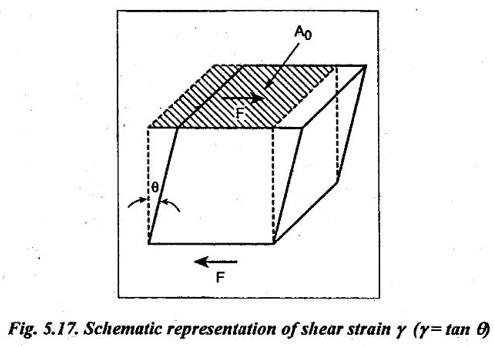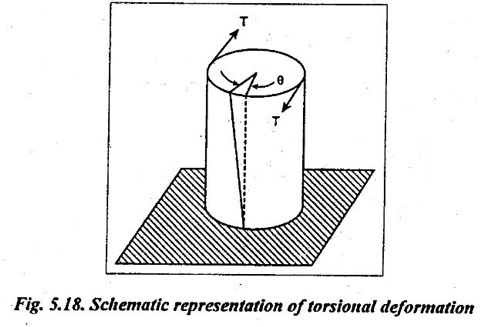There are two main types of test which may be used for the determination of the properties of a material in shear.
SHEAR TESTS
✔ There are two main types of test which may be used for the determination of the properties of a material in shear. They are :
1. Test performed using a pure shear force↑, and
2. Test performed using the application of a torque to a cylindrical specimen i.e., torsion test.
† Shear force simply means a tangential force.
1. Shear Test Using a Pure Shear Force
✔ Fig.5.17 illustrates the shear test, performed using a pure shear force. In this type, the force is imposed parallel to the upper and lower faces of the body.

✔ Shear stress: The shear stress or shear strength is the value of load applied tangentially to shear it off across the resisting section. Mathematically,
Shear stress,τ = F / Ao ….. (5.13)
where
F = Shear force applied, and
Ao = Area of shear (as shown in Fig.5.17)
✔ Shear strain: The shear strain is defined as the tangent of the strain angle 0, as indicated in Fig.5.17.
Mathematically, shear strain, γ = tan θ
1. Testing Methods
✔ Three main systems used for shear tests are:
(i) Double shear system for round bar test-pieces using a fork and eye device;
(ii) Double knife shear system for specimens with a rectangular section; and
(iii) The shearing of a disc from sheet materials using a punch and die.
✓ The test equipment generally takes the form of attachments which can be used in conjunction with a universal testing machine.
✓ The disadvantages of these methods are:
■ Always there will be bending of the test-piece, therefore the stresses within the material will not be of the pure shear type, but they include bending stresses.
■ Very difficult to obtain accurate quantitative data from them.
2. Torsion Test
✓ Torsion is a variation of pure shear, wherein a structural member is twisted in the manner of Fig.5.18.
✓ Torsional forces produce a rotational motion about the longitudinal axis of one end of the member relative to the other end.

✓ To determine the shear strength t, the following general torsion equation can be applied within the elastic range :

where
τ = Shear stress
r = Radius of the cylinder,
T = Applied torque,
J = Second polar moment of area,
G = Modulus of rigidity of the material,
θ = Angle of twist in radians, and
L = Gauge length of the test-piece.
No comments:
Post a Comment